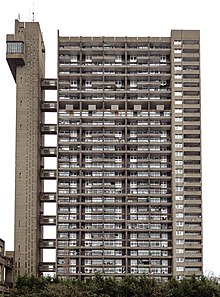| Trellick Tower | |
|---|---|
 Trellick Tower with its separate access tower with abutting plant house | |
| General information | |
| Type | Residential flats |
| Architectural style | Brutalist |
| Location | Kensal Green, Royal Borough of Kensington and Chelsea, London |
| Coordinates | 51°31′25″N 00°12′20″W / 51.52361°N 0.20556°W |
| Completed | 28 June 1972 |
| Height | |
| Roof | 98 metres (322 ft) |
| Technical details | |
| Floor count | 31[1] |
| Design and construction | |
| Architect(s) | Ernő Goldfinger |
| Designations | |
Listed Building – Grade II* | |
| Official name | Trellick Tower |
| Designated | 22 December 1998 |
| Reference no. | 1246688 |
Trellick Tower is a Grade II* listed tower block on the Cheltenham Estate in Kensal Town, London. Opened in 1972, it was commissioned by the Greater London Council and designed in the Brutalist style by architect Ernő Goldfinger. The tower was planned to replace outdated social accommodation, and designed as an improvement on Goldfinger's earlier Balfron Tower in Poplar, East London. It was the last major project he worked on, and featured various space-saving designs, along with a separate access tower containing a plant room.
High-rise apartments and Brutalist architecture were falling out of favour by the time the tower was completed, and it became a magnet for crime, vandalism, drug abuse and prostitution. Conditions gradually improved in the 1980s after the establishment of a residents' association. Security measures were put in place and a concierge was employed, which led to lower crime levels. By the 1990s, the tower had become a desirable place to live, and although it still contains predominantly social housing, demand for private flats has remained high. A local landmark, it has been Grade II* listed since 1998, and has retained its distinctive concrete facade as a result. A fire broke out in 2017, but the concrete structure meant damage was limited, unlike the nearby Grenfell Tower. Trellick Tower has featured in film and television several times.
